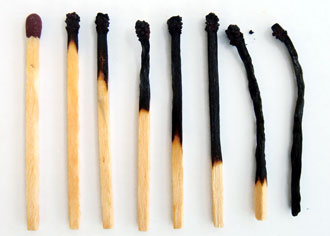The Peyronie's Stages
Acute And Chronic Peyronie's
There are two Peyronie's stages, the acute and chronic Peyronie's phases.
The Acute Peyronie's Disease
The first stage is called the acute or active Peyronie's phase. This stage usually lasts up to 12 to 18 months. This is when most of the changes to the penis occur, these changes should stabilize during the chronic or stable Peyronie's phase.

During this initial acute stage, over half of men with Peyronie's experience some form of penile pain / painful erections.
Penis pain is actually one of the first Peyronie's Symptoms that most men notice.
The plaque is forming during the active Peyronie's stage and there is inflammation in the area where the plaque is forming.
The plaque can cause deformity of the penis. The most common is penis curvature (bent penis), but others are indentation, hourglass narrowing, loss of girth and penis shrinkage / shortening.
Since so much is changing during the initial active phase, most Peyronie's specialists now believe it is important to start treatment during the acute Peyronie's stage.
Most doctors now believe it is actually crucial for the long-term outcome.
The changes in the tissue elasticity in the acute stage are believed to be reversible whereas the loss of elasticity in the chronic stage is not. This is why doctors believe penis curvature (bending) responds best to medical therapy during the early active Peyronie's phase.
The goal should be to stop the development of the disease, i.e. to reduce inflammation and reduce the likelihood of further penis deformity. Hopefully you will also experience full or partial reverse of your Peyronie's penis problems.
I started My Peyronie's Treatment within 6 months of noticing my first Peyronie's symptoms. I of course can't be sure if that made all the difference for me but I'm glad I didn't “wait and see” as only 5 - 15% of men with Peyronie's disease improve without any treatment. Those odds are against you and I was not willing to take that risk.
More and more Peyronie's disease specialists agree with this... you should not waste the acute Peyronie's stage in waiting and hoping for the best.
You can expect better results
the sooner you start your Peyronie's treatment
The Chronic Peyronie's Disease
The second phase is called the chronic or stable Peyronie's stage. This stage is usually reached around 12 – 18 months after the first symptoms appear.
During the chronic phase, the development of the disease usually stabilizes, hence the name stable phase.
Penis pain usually resolves on its own and the plaque and penis deformity is likely to stabilize, i.e. not get worse but unlikely to improve much either without a treatment.
Erectile Dysfunction may, or may not, occur during this phase, or continue to develop. There may also be calcification of the plaque.
The acute Peyronie's phase can return if more injury / trauma occur to your penis. Men can have acute stage flare-ups periodically over the years.
Even though most Peyronie's specialists now recommend starting treatment a.s.a.p. and ideally during the active phase, many men get positive results from their treatment during the chronic stage.
Therefore, if you have already reached the chronic Peyronie's stage, don't give up hope. Continue reading and develop a plan of action with your doctor and / or partner.



